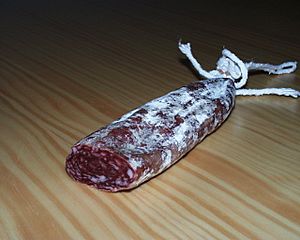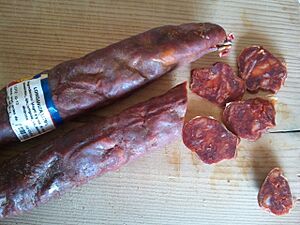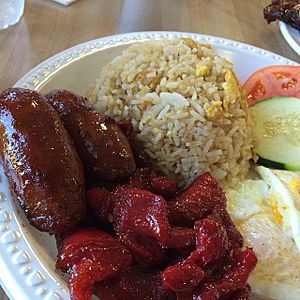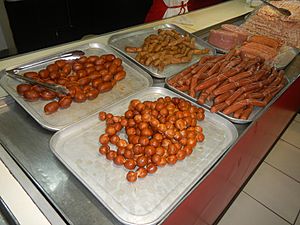Longaniza facts for kids

|
|
| Type | Sausage |
|---|---|
| Place of origin | Spain |
| Main ingredients | pork and seasoning |

Longaniza is a type of sausage that comes from Spain. It's a lot like chorizo, and it's also similar to the Portuguese sausage called linguiça. What makes longaniza special can be different depending on where you are.
This tasty sausage is popular in many countries. You can find it in Spain, Argentina, Uruguay, Puerto Rico, the Dominican Republic, El Salvador, Mexico, and Chile. In the Philippines, it's called longganisa. There are hundreds of different kinds there, each with its own special taste and shape!
Contents
Longaniza Around the World
Spain
In Spain, longaniza sausages are usually long and thin. They are different from chorizo because they use black pepper instead of paprika. They might also have other spices like nutmeg.
Argentina and Uruguay
In Argentina and Uruguay, longaniza is a very long sausage. It's cured and dried, meaning it's preserved without cooking. It gets its special flavor from ground anise seeds. This gives it a unique smell and a slightly sweet taste. People mostly eat it as a snack or in sandwiches. It's rarely cooked.
Chile
In Chile, longaniza is often grilled at a barbecue. People enjoy it with bread, making a sandwich called a choripán. The city of Chillán is famous for its longanizas. Even Chillán's football team, Ñublense, is nicknamed The Clockwork Longaniza! During the national celebrations on September 18th, lots of longaniza is prepared.
Mexico
Mexican longaniza is usually longer and spicier than Mexican chorizo. It's often chopped up and mixed with eggs, tomatoes, and chile peppers. This dish is called longanisa con huevo. People eat it with tortillas for breakfast.
Puerto Rico
Puerto Rican longaniza is usually made from pork. But you can also find it made with chicken or turkey. It gets its reddish-orange color from annatto seeds. A popular meal is rice with longaniza.
Dominican Republic
In the Dominican Republic, longaniza has been made since old times. It's prepared with bitter orange juice (or lime), garlic, oregano, and salt. Pork intestines are used for the casing. Then, the longaniza is left to dry in the sun for a few days. People usually fry it in its own fat or in vegetable oil. Many families make it at home, so the quality can be different. The best kind usually has about 70% lean meat.
Philippines
In the Philippines, this sausage is called longganisa (or sometimes chorizo). It's flavored with local spices. Often, it's colored red, yellow, or orange using achuete seeds.
Longganisa is usually a fresh or smoked sausage. It's made with different amounts of lean meat and fat. Common ingredients include garlic, black pepper, salt, and vinegar. Some types also add paprika, chili, or anise liqueur.
Most longganisa are either sweet (called jamonado or hamonado) or garlicky (called de recado). Most are made with pork. But unlike Spanish longaniza, Filipino longganisa can also be made with chicken, beef, or even tuna. Some homemade sausages are just patties without a casing. These are called longganisang hubad, meaning "skinless sausages".
There are many kinds of longganisa in the Philippines. Each region often has its own special type. For example, there's Vigan longganisa and Alaminos longganisa. The Pampanga longganisa is one of the most well-known because it's made in large amounts for stores.
Here are a few popular types of longganisa from the Philippines:
- Alaminos longganisa - a garlicky pork sausage from Pangasinan.
- Cabanatuan longganisa (or Batutay) - a beef sausage from Nueva Ecija.
- Calumpit longganisa (or Longganisang Bawang) - from Bulacan.
- Chorizo de Cebu (or Longganisa de Cebu) - a sweet pork sausage from Cebu.
- Lucban longganisa - a garlicky pork sausage from Quezon, known for using oregano.
- Pampanga longganisa - a sweet pork sausage from Pampanga.
- Tuguegarao longganisa (or Longganisang Ybanag) - a garlicky pork sausage from Cagayan Valley.
- Vigan longganisa - a garlicky pork sausage from the Ilocos Region.
See also
 In Spanish: Longaniza para niños
In Spanish: Longaniza para niños



